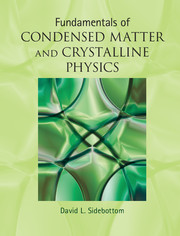 Fundamentals of Condensed Matter and Crystalline Physics
Fundamentals of Condensed Matter and Crystalline Physics from Part I - Structure
Published online by Cambridge University Press: 05 August 2012
Introduction
In this final chapter on the subject of structures, we turn our attention to magnetic materials. Why? Because magnetic materials are illustrative of yet another level of structure that often arises in condensed matter, beyond that of particle arrangements. As we will see, magnetic particles have a property of net spin and a magnetic moment whose orientation in space is largely unrestricted. Regardless of whether a large system of magnetic particles is positioned in an ordered or disordered manner, their spins represent an additional layer of ordering. The moments could be randomly oriented or aligned in a common direction. In ferromagnetic systems, these moments interact with one another to promote a local alignment of the moments which can eventually spread over the entire system. This is reminiscent of how pairwise bonding between particles eventually leads to crystallization of a liquid, and it is the archetype for a wide variety of phase transitions in which order appears in the form of correlated regions emerging from a disordered host.
The ordering process
So far, our discussion of structure has focused entirely on particles: their relative positions and the forces that hold them together. We have seen that arrangements of particles fall into either an ordered or disordered pattern which can be characterized by the level of symmetry present. By virtue of its disorder, the liquid has rotational invariance and an infinite symmetry (on average). The crystal, however, conforms to a space lattice and possesses only a discrete set of symmetry operations. In the process of forming a crystal from the liquid, the symmetry is often said to be “broken”.
To save this book to your Kindle, first ensure [email protected] is added to your Approved Personal Document E-mail List under your Personal Document Settings on the Manage Your Content and Devices page of your Amazon account. Then enter the ‘name’ part of your Kindle email address below. Find out more about saving to your Kindle.
Note you can select to save to either the @free.kindle.com or @kindle.com variations. ‘@free.kindle.com’ emails are free but can only be saved to your device when it is connected to wi-fi. ‘@kindle.com’ emails can be delivered even when you are not connected to wi-fi, but note that service fees apply.
Find out more about the Kindle Personal Document Service.
To save content items to your account, please confirm that you agree to abide by our usage policies. If this is the first time you use this feature, you will be asked to authorise Cambridge Core to connect with your account. Find out more about saving content to Dropbox.
To save content items to your account, please confirm that you agree to abide by our usage policies. If this is the first time you use this feature, you will be asked to authorise Cambridge Core to connect with your account. Find out more about saving content to Google Drive.